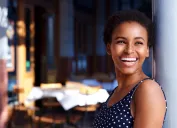6 Tips for Dyeing Your Hair If You're Over 60, According to Stylists
You may need to adjust your routine as your hair texture changes.

Whether getting a routine touch-up, trying to hide those stray grays, or embracing your bold side and going for a more daring shade, dyeing our hair is a ritual many of us have partaken in for a much of our lives. But as you age, your hair begins to have have different needs, so the same old routine may no longer serve you. It's not only the color that changes, but the texture as well, so it's extra important we are doing all we can to keep our hair healthy and strong.
Interestingly, dyeing our gray hair can help. Jessica Shults, a stylist and owner of Twisted Scissors Salon, says that since gray hair lacks melanin, which can lead to a dry and brittle texture, coloring it can seal the cuticle of each strand making it feel fuller and smoother—just not too often! Keep reading to discover more hairstylist tips for dyeing your hair over 60.
READ THIS NEXT: 5 Tips for Having Bangs Over 60, According to Stylists.
1
Consult a professional.
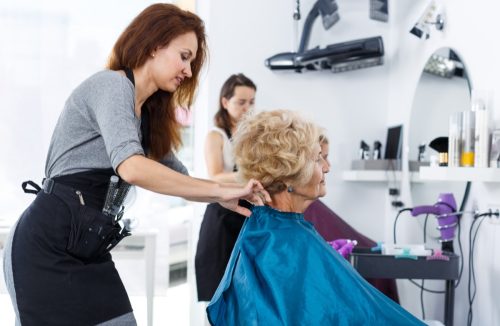
If you're looking to dye your hair, seeing a professional stylist is always the way to go. This is the best way to ensure you get the right shade and the color you're looking for rather than experimenting with boxed dye. It may cost more, but knowing that the result will be better for your hair, and your look, might make it worth it.
Dawna Jarvis, a master stylist at the Canyon Salon says that "a professional can help you choose the right color to complement your skin tone, eye color, and personality." They'll also be able to guide you in finding which products will work best for maintaining the color and prevent damage.
2
Go with lighter shades.
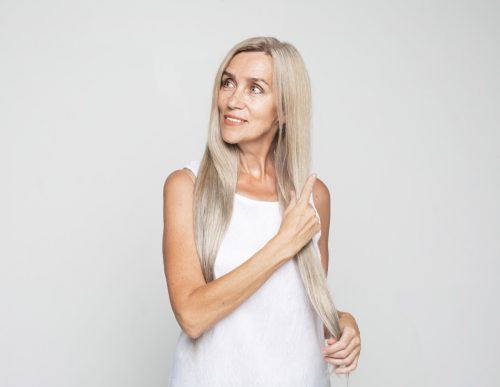
"Typically women over 60 have more than 50 percent gray hair," says Shults. "The blonder you go, the more it will blend in with the grays as it grows out."
If you are a brunette and your goal is to cover up your grays, though it may seem counterintuitive, going lighter is your best bet too. "If you color your hair dark, then those pesky gray hairs stand out like crazy, and you have to go back quicker to touch up the roots," says Shults.
Edna Ferber, a hairstylist and founder of Shampoos Hub, says dyeing your hair dark can also age you. "Too dark will make your hair lose its naturalness and emphasize the signs of age on your skin," she says.
For more beauty advice delivered straight to your inbox, sign up for our daily newsletter.
3
Choose a dye with a warm or neutral pigment.

Though it's a good idea to go lighter rather than darker as you age, it's also important to find a shade that won't wash you out. Anything with cool undertones is not the best idea for a person over 60, no matter their skin tone.
"As you age, the pigmentation on the skin will become less and less, so you should choose a dye with a neutral or warm pigment—these hair colors can give you a radiant, vibrant look," Edna Ferber, a hairstylist and founder of Shampoos Hub, tells Best Life. "Try to look as natural as possible by choosing a color one to two tones lighter than your natural hair. It will give a youthful look, cover the gray hairs, and make them harmonious with the whole hair."
4
Consider highlights.
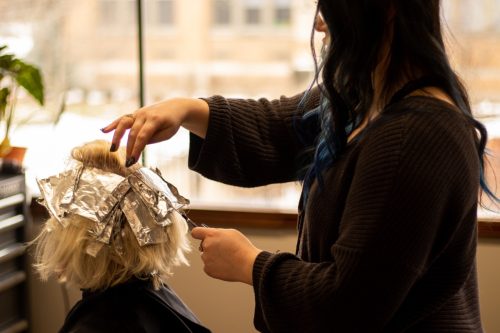
Dyeing your hair can not only be costly, it can also be time-consuming—especially if you're trying to really hide the gray.
A good solution: trying out highlights. This lower maintenance look will still blend in with the grays but will be easier on your strands and your wallet.
"They will help to add depth and dimension to your look without being too harsh on the hair and scalp," says Krysta Biancone, co-founder at Amari Salon & Spa and hairstylist at Hair by Krysta.
Another good option is balayage, which is basically hand-painted highlights. "Dyeing too many times, and too much hair dye, causes the hair to deposit color and easily become dull," says Ferber. "This is the time when you can think about balayage dyeing, [which] creates a multi-dimensional color that makes your hair soft."
5
Use deep conditioning treatments.
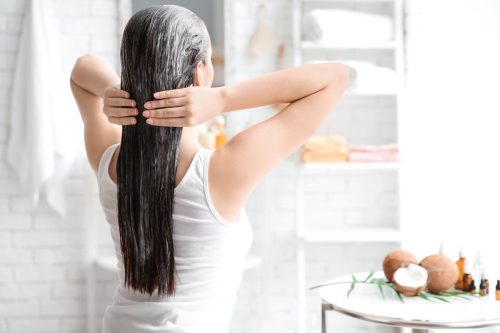
Gray hair is often more coarse and dry in texture, so it is in your best interest to make sure it is hydrated as possible.
Biancone recommends using a deep conditioning treatment both before and after you get color done to keep it healthy for the long term. It can also prevent damage and breakage at the ends.
Shults adds that "a nice treatment after coloring also helps in making the hair softer and shinier."
READ THIS NEXT: If You're Over 65, This Hairstyle Is Aging You, Experts Say.
6
Pick a color that suits your personality.

"Hair color is often known to be an expression of our personality," Jarvis says. So don't be afraid to go out of your comfort zone and dye your hair a new shade that fits your mood.
We did lay down some guidelines, but remember that experimenting is also part of the fun of getting your hair done!






